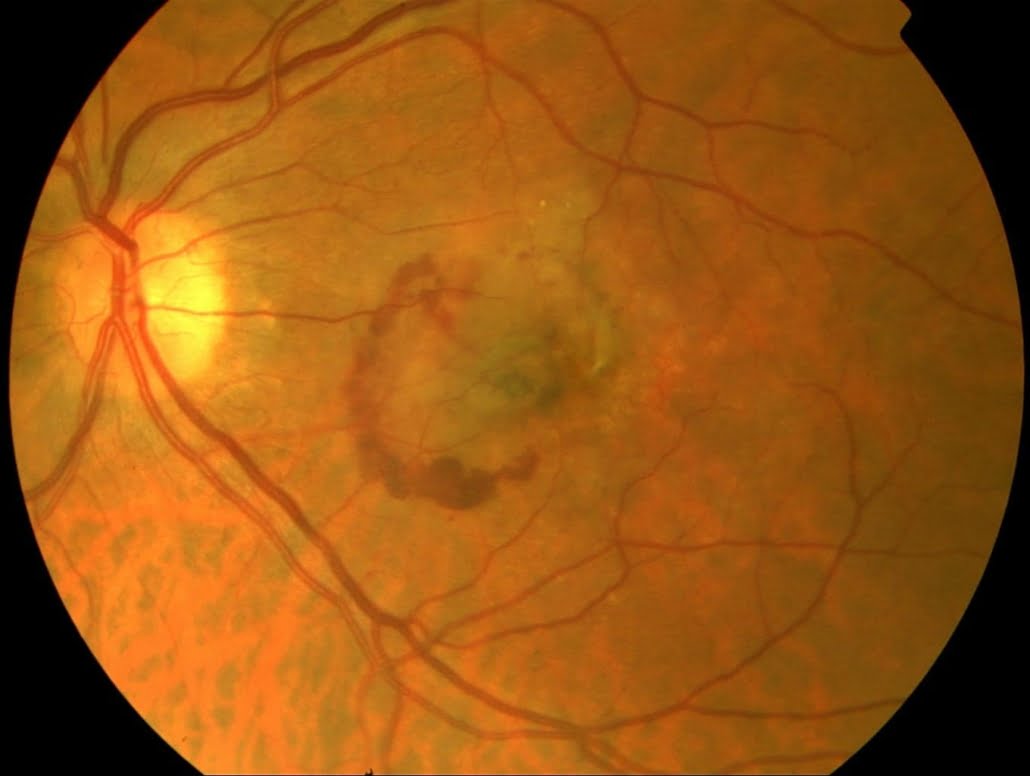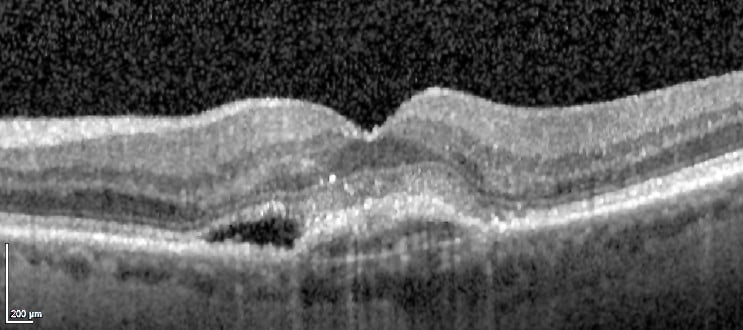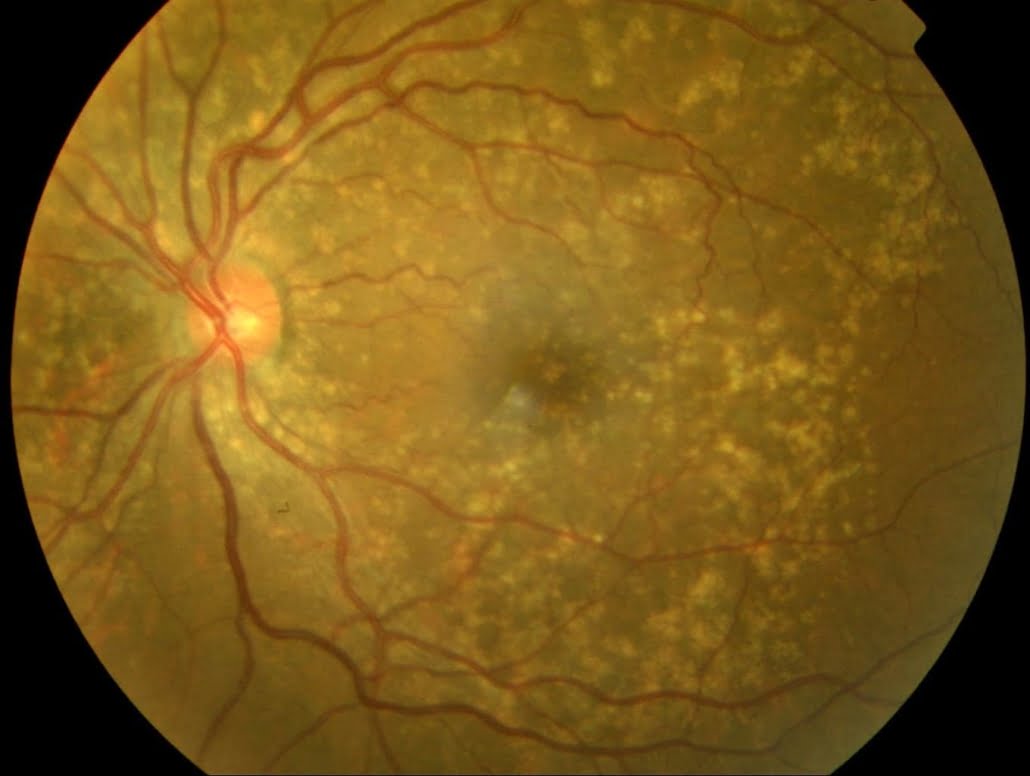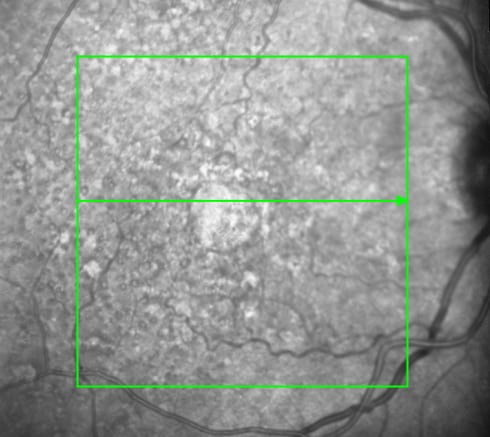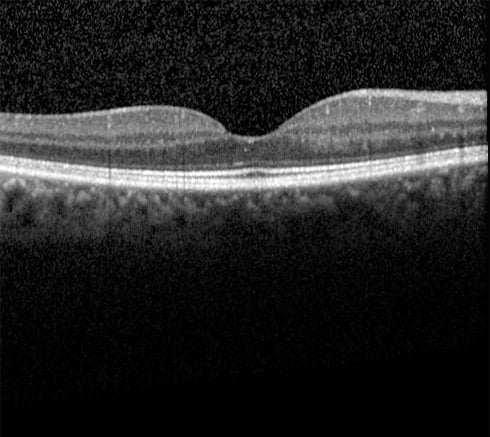Background and symptoms
In developed nations, age-related macular degeneration (AMD) causes more blindness than all other eye diseases combined. There are two types of AMD – exudative (wet) AMD, and non-exudative (dry) AMD.
In wet AMD, abnormal new vessels grow into the retina. These leak fluid and bleed, damaging the macular architecture. Dry AMD has a broader spectrum of severity. Mild dry AMD may be asymptomatic, but with time the macular photoreceptors may slowly atrophy and die. Both wet and dry AMD may result in loss of central vision over time, typically days or weeks with wet AMD, but more likely months, years or even decades with dry AMD.
Wet AMD
Left fundus photograph of wet AMD showing a central grey/green choroidal neovascular lesion with surrounding haemorrhage.
This OCT scan shows a cross section of the macula in wet AMD. There is a collection of fluid in the deep layers of the central macula, unlike in a normal OCT scan.
Normal OCT.
Dry AMD
Fundus photograph showing drusen scattered throughout the macula and beyond.
Dry AMD infrared image showing geographic atrophy.
OCT image showing central geographic atrophy.
Normal OCT.
Wet AMD Treatment
Intravitreal injections
The mainstay of treatment for wet AMD is intravitreal injections of drugs that inhibit vascular endothelial growth factor (VEGF). Anti-VEGF agents target the new vessels responsible for wet AMD. There are high quality RCTs showing benefit with aflibercept, ranibizumab, brolucizumab and bevacizumab (off-label).
AREDS vitamin supplementation
Patients with wet AMD in one eye may benefit from specific vitamin supplements, to reduce the risk of the fellow eye becoming involved. There is debate in the literature, in part because the studies into vitamin supplementation were very complex. However, the topline result of the initial, main AREDS study was that a specific vitamin combination reduced the risk of fellow eye involvement by about a quarter. There are many AMD vitamin supplements on the market, but only a small minority mirror the AREDS formula, so it is important to select the right one. This is particularly important for smokers or former smokers, as there is a concern that the wrong vitamin combination may increase the risk of lung cancer.
A safe option for both smokers and non-smokers is Viteyes 2, one softgel twice daily, but there are others. Use only AREDS2 formulas for smokers or former smokers.
Dry AMD Treatment
Unfortunately, there a far fewer treatment options for dry AMD, but there are often things that can be done to help. For example, low vision aids may maximise the available vision, as may treatment of concomitant disease such a cataract. Support groups and patient information can also help, and for those with advanced disease, registration as being sight impaired may help mobilise resources.
Enrolling in clinical trials
Patients who wish to explore the option of enrolling in clinical trials of wet and dry AMD are welcome to contact my research coordinator at King’s College Hospital on 020 3299 1297. There are many exciting new AMD technologies in development. The coordinator will be able to outline the trials that are currently underway.
Referral Guidelines
Refer Wet AMD urgently, as I would usually want to see the patient within a week or two.
Dry AMD can be referred routinely.
Further information
The Macular Society has excellent information on both wet and dry AMD.
A information leaflet for patients can be found in the patient information leaflet.
